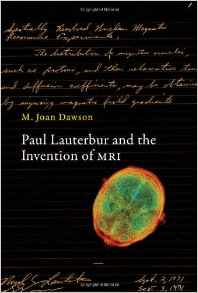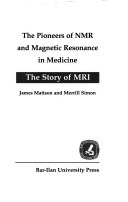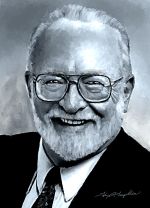Paul C. Lauterbur Ph.D.
Paul C. Lauterbur Ph.D.
The Nobel Prize in Physiology or Medicine 2003
Nobel Co-recipient Sir Peter Mansfield
The President’s National Medal of Science – Physical Sciences 1987
The National Medal of Technology and Innovation 1988
“Every great idea in history has the red stamp of rejection on its face. If you scratch any innovation’s surface, you’ll find the scars: they’ve been roughed up and thrashed around by the masses and the leading minds before they made it into your life.”
Biography
Books
Journal Articles
Patents
History of Discovery
Death
Harassment
Health
Humor/Quotations
Images
Maverick
Nat’l Medal, Science
Videos
General Nobel Prize Information
History or Discovery
 An Excursion into the History of Magnetic Resonance Imaging. At bottom of page please click on successive page numbers.
An Excursion into the History of Magnetic Resonance Imaging. At bottom of page please click on successive page numbers.
![]()
© Nature Publishing Group 2006
Image Formation by Induced Local Interactions: Examples Employing Nuclear Magnetic Resonance. Nature 242, 190-191 (1973).
MRI – a new way of seeing
In 1973, Paul Lauterbur described an imaging technique that removed the usual resolution limits due to the wavelength of the imaging field. He used two fields: one interacting with the object under investigation, the other restricting this interaction to a small region. Rotation of the fields relative to the object produces a series of one-dimensional projections of the interacting regions, from which two- or three-dimensional images of their spatial distribution can be reconstructed. Application of this technique as magnetic resonance imaging is now widespread.

About the Author: M. Joan Dawson is Associate Professor Emerita in the School of Molecular and Cellular Biology at the University of Illinois at Urbana-Champaign. She was married to Paul Lauterbur from 1984 until his death in 2007.
Overview
On September 2, 1971, the chemist Paul Lauterbur had an idea that would change the practice of medical research. Considering recent research findings about the use of nuclear magnetic resonance (NMR) signals to detect tumors in tissue samples, Lauterbur realized that the information from NMR signals could be recovered in the form of images-and thus obtained noninvasively from a living subject. It was an unexpected epiphany: he was eating a hamburger at the time. Lauterbur rushed out to buy a notebook in which to work out his idea; he completed his notes a few days later. He had discovered the basic method used in all MRI scanners around the world, and for this discovery he would share the Nobel Prize for Physiology or Medicine in 2003. This book, by Lauterbur’s wife and scientific partner, M. Joan Dawson, is the story of Paul Lauterbur’s discovery and the subsequent development of the most important medical diagnostic tool since the X-ray.
With MRI, Lauterbur had discovered an entirely new principle of imaging. Dawson explains the science behind the discovery and describes Lauterbur’s development of the idea, his steadfastness in the face of widespread skepticism and criticism, and related work by other scientists including Peter Mansfield (Lauterbur’s Nobel co-recipient), and Raymond Damadian (who famously feuded with Lauterbur over credit for the ideas behind MRI). She offers not only the story of one man’s passion for his work but also a case study of how science is actually done: a flash of insight followed by years of painstaking work.
About the Author
M. Joan Dawson is Associate Professor Emerita in the School of Molecular and Cellular Biology at the University of Illinois at Urbana-Champaign. She was married to Paul Lauterbur from 1984 until his death in 2007. “Life is so strange. It was because of the tortured history of NMR Specialties that Paul happened to be on hand to witness the experiments that raised in his mind the possibility of Magnetic Resonance Imaging. Paul was always squeamish about everything medical and biological, everything that had to do with blood and other tissues. He was loath to go to doctors and totally intimidated by the idea that he might have to have an injection or to have blood drawn. So finding a way to do NMR studies noninvasively took on a special meaning for him.”
Reviews
“The book reads well and has something for everyone; I would particularly recommend it to young researchers.”-Chemistry World
Endorsements
“Paul Lauterbur and the Invention of MRI is a fascinating story, told by the loving wife of a major contributor. Science reports are seldom just right or wrong but live from personal impressions that bring colors into the picture. This account of a major advancement in medicine offers a rare glimpse into the inner workings of science progress.”-Richard R. Ernst, ETH, Zürich, Switzerland; 1991 Nobel Laureate in Chemistry
Book Excerpt. In Chapter 6, “The first fruitful weeks,” author M. Joan Dawson describes her late husband’s first steps in the invention of a revolutionary imaging technology.


Format:
Available in Chemical Heritage Foundation, Othmer Library of Chemical History, Philadelphia, PA 19106 USA.


Find in a library near you. In OCLC Worldcat website search box, copy and paste name of laureate. Click. In list of books, click book of interest to you. Computer probably uses a 5-digit zip code where you are physically located. Scroll down to libraries near you which possess book. Possibly more than one person with same name.
